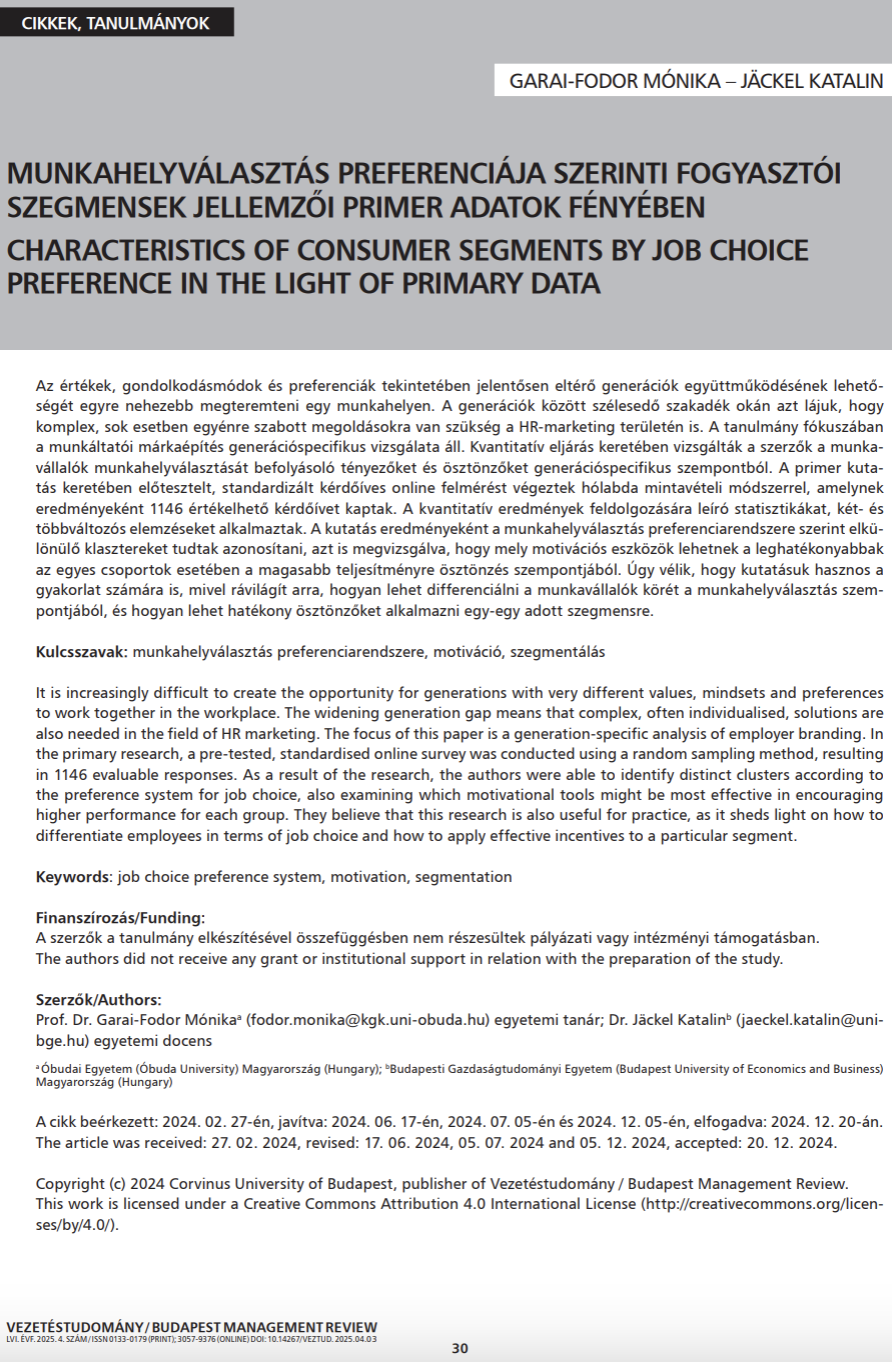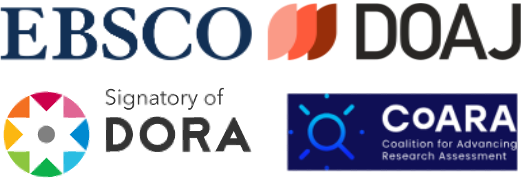Characteristics of consumer segments by job choice preference in the light of primary
DOI:
https://doi.org/10.14267/VEZTUD.2025.04.03Keywords:
job choice preference system, motivation, segmentationAbstract
It is increasingly difficult to create the opportunity for generations with very different values, mindsets and preferences to work together in the workplace. The widening generation gap means that complex, often individualised, solutions are also needed in the field of HR marketing. The focus of this paper is a generation-specific analysis of employer branding. In the primary research, a pre-tested, standardised online survey was conducted using a random sampling method, resulting in 1146 evaluable responses. As a result of the research, the authors were able to identify distinct clusters according to the preference system for job choice, also examining which motivational tools might be most effective in encouraging higher performance for each group. They believe that this research is also useful for practice, as it sheds light on how to differentiate employees in terms of job choice and how to apply effective incentives to a particular segment.Downloads
References
Alnıaçık, E., & Alnıaçık, Ü. (2012). Identifying dimensions of attractiveness in employer branding: effects of age, gender, and current employment status. Procedia – Social and Behavioral Sciences, 58, 1336–1343. https://doi.org/10.1016/j.sbspro.2012.09.1117
Alves, P., Santos, V., Reis, I., Martinho, F., Martinho, D., Correia Sampaio, M., José Sousa, M., & Au-Yong-Oliveira, M. (2020). Strategic talent management: the impact of employer branding on the affective commitment of employees. Sustainability, 12(23), 9993. https://doi.org/10.3390/su12239993
Amundson, N.E. (1995). An interactive model of career decision making. Journal of Employment Counseling, 32(1), 11–21. https://doi.org/10.1002/j.2161-1920.1995.tb00420.x
Arachchige, J.H.B., & Robertson, A. (2013). Employer attractiveness: comparative perceptions of undergraduate and postgraduate students. Sri Lankan Journal of Human Resource Management, 4(1), 33–48. http://dx.doi.org/10.4038/sljhrm.v4i1.5616
Backhaus, K., & Tikoo, S. (2004). Conceptualising and researching employer branding. Career Development International, 4(5), 501–217. https://doi.org/10.1108/13620430410550754
Baum, M. (2013). How to attract applicants in the Atlantic versus the Asia-Pacific region - A cross-national analysis on China, India, Germany, and Hungary. Journal of World Business, 48(2), 175–185. https://doi.org/10.1016/j.jwb.2012.07.002
Bendaraviciene, R., Krikstolaitis, R., & Turauskas, L. (2013). Exploring employer branding to enhance distinctiveness in higher education. European Scientific Journal, 9(19), 45-78. https://doi.org/10.19044/esj.2013.v9n19p%25p
Bergstrom, A., Blumenthal, D., & Crothers, S. (2002). Why internal branding matters: the case of Saab. Corporate Reputation Review, 5(2–3), 133–142. https://doi.org/10.1057/palgrave.crr.1540170
Berthon, P., Ewing M.J., & Hah L.L. (2005). Captivating company: dimensions of attractiveness in employer branding. International Journal of Advertising, 24(2), 151–172. https://doi.org/10.1080/02650487.2005.11072912
Betáková, J., Wu, J., Rudnak, I., & Magda, R. (2021). Employment of foreign students after graduation in Hungary in the context of entrepreneurship and susta8(4), 553–570. https://doi.org/10.9770/jesi.2021.8.4(33)
Betsworth, D.G., & Hansen, J.I.C. (1996). The categorization of serendipitous career development events. Journal of Career Assessment, 4(1), 91–98. https://doi.org/10.1177/106907279600400106
Bite, P., & Konczos-Szombathelyi, M. (2020). Employer branding concept for small- and medium-sized family firms. Journal of International Studies, 13(3), 143–160. https://doi.org/10.14254/2071-8330.2020/13-3/10
Cabral, A.C., & Salomone, P.R. (1990). Chance and careers: normative versus contextual development. The Career Development Quarterly, 39(1), 5–17. https://doi.org/10.1002/j.2161-0045.1990.tb00230.x
Chaiken, S., & Trope, Y. (1999). Dual-process theories in social psychology. Guilford Press.
Denys, J. (2020, June 20). Managing your employer brand during a crisis. https://www.randstad.com.hk/hr-trends/employer-brand/managing-your-employerbrand-during-a-crisis
Deutsch, R., & Strack, F. (2006). Reflective and Impulsive Determinants of Addictive Behavior. In Handbook of Implicit Cognition and Addiction (pp. 45–58). SAGE Publications, Inc. https://doi.org/10.4135/9781412976237.n4
Easa, N.F., & Bazzi, A.M. (2020). The influence of employer branding on employer attractiveness and employee engagement and retention. International Journal of Customer Relationship Marketing and Management, 11(4), 48–69. https://doi.org/10.4018/IJCRMM.2020100104
Edwards, W. (1954). The theory of decision making. Psychological Bulletin, 51(4), 380–417. https://doi.org/10.1037/h0053870
Egerová, D., Kutlák, J., & Eger, L. (2021). Millennial job seekers’ expectations: How do companies respond? Economics & Sociology, 14(1), 46–60. https://doi.org/10.14254/2071-789X.2021/14-1/3
Evans, J.St.B.T. (2011). Dual-process theories of reasoning: Contemporary issues and developmental applications. Developmental Review, 31(2–3), 86–102. https://doi.org/10.1016/j.dr.2011.07.007
Gati, I. (1986). Making career decisions: A sequential elimination approach. Journal of Counseling Psychology, 33(4), 408–417. https://doi.org/10.1037/0022-0167.33.4.408
Gelatt, H.B. (1962). Decision-making: A conceptual frame of reference for counseling. Journal of Counseling Psychology, 9(3), 240–245. https://doi.org/10.1037/h0046720
Gelatt, H.B. (1989). Positive uncertainty: A new decision- making framework for counseling. Journal of Counseling Psychology, 36(2), 252–256. https://doi.org/10.1037/0022-0167.36.2.252
George, W.R. (1977). The retailing of services: A challenging future. Journal of Retailing, 53(3), 85–98.
George, W.R. (1990). Internal marketing and organizational behavior: A partnership in developing customer- conscious employees at every level. Journal of Business Research, 20(1), 63–70. https://doi.org/10.1016/0148-2963(90)90043-D
Harman, W.W. (1981) Rationale for good choosing. Journal of Humanistic Psychology, 21, 5–12. https://doi.org/10.1177/002216788102100102
Hart, D.H., Rayner, K., & Christensen, E.R. (1971). Planning, preparation, and chance in occupational entry. Journal of Vocational Behaviour, 1(3), 279–185. https://doi.org/10.1016/0001-8791(71)90029-7
Hodkinson, P., & Sparkes, A. C. (1997). Careership: a sociological theory of career decision making. British Journal of Sociology of Education, 18(1), 29–44. https://doi.org/10.1080/0142569970180102
Jarvis, S.P. (2000). The Next Generation. In M. Sallai (Ed.), Careers Guidance and Counselling. Theory and Practise for the 21th Century. Nemzeti Szakképzési Intézet.
Jiang, T., & Iles, P. (2011). Employer‐brand equity, organizational attractiveness and talent management in the Zhejiang private sector, China. Journal of Technology Management in China, 6(1), 97–110. https://doi.org/10.1108/17468771111105686
Kenderfi, M. (2012). A pályaorientáció folyamatának korszerű értelmezése. In K. Szilágyi (Ed.), A pályaorientáció szerepe a társadalmi integrációban (pp. 6-11). ELTE, TÁTK.
Kőkuti, T., Balázs, L., & Keszi-Szeremlei, A. (2023). A munkaérték-preferenciák nemzetközi összehasonlításának vizsgálata. Civil Szemle, 20(7), 77-93. https://www.civilszemle.hu/wp-content/uploads/2024/02/Csz-2024-kulonsz.7.-web.pdf
Kőműves, Zs., Poór, J., & Karácsony, P. (2022). Vezetői motiváció a munkaerő-megtartás szolgálatában, különös tekintettel a dél-dunántúli régió kis- és középvállalkozásaira. Marketing és Menedzsment, 56(2), 72-82. https://doi.org/10.15170/MM.2022.56.02.07
Liu, Y., Vrontis, D., Visser, M., Stokes, P., Smith, S., Moore, N., Thrassou, A., & Ashta, A. (2021). Talent management and the HR function in cross-cultural mergers and acquisitions: The role and impact of bi-cultural identity. Human Resource Management Review, 31(3),100744. https://doi.org/10.1016/j.hrmr.2020.100744
Malhotra, N.K., & Simon, J. (2017). Marketingkutatás. Akadémiai Kiadó.
Nguyen, N.T., Mai, V.D., Chris, R., & Mirjana, P.B. (2022). Generation Z job seekers’ expectations and their job pursuit intention: Evidence from transition and emerging economy. International Journal of Engineering Business Management, 14. https://doi.org/10.1177/18479790221112548
Minchington, B. (2009). “Help wanted!” https://www.marketingmix.co.za/pebble.asp?r
Mitchell, K.E., Al Levin, S., & Krumboltz, J.D. (1999). Planned happenstance: constructing unexpected career opportunities. Journal of Counseling & Development, 77(2), 115–124. https://doi.org/10.1002/j.1556-6676.1999.tb02431.x
Monteiro, B., Santos, V., Reis, I., Sampaio, M.C., Sousa, B., Martinho, F., José Sousa, M., & Au-Yong-Oliveira, M. (2020). Employer branding applied to SMEs: A pioneering model proposal for attracting and retaining talent. Information, 11(12), 574. https://doi.org/10.3390/info11120574
Portfolio.hu. (2023, March 19). Erre a hat területre kell figyelnie a cégeknek, hogy meg tudják tartani legjobb dolgozóikat. https://www.portfolio.hu/gazdasag/20230319/erre-a-hat-teruletre-kell-figyelnie-a-cegeknek-hogy-meg-tudjak-tartani-legjobb-dolgozoikat-603528
PwC. (2023). Munkaerőpiaci preferencia felmérés 2023. https://www.pwc.com/hu/hu/szolgaltatasok/hr_tanacsadas/evp.html
Randstadt (2024, április 24). Mire vágynak leginkább a hazai munkavállalók 2024-ben? https://www.randstad.hu/workforce-insights/employer-branding/lego-bt-mercedes-benz-a-legvonzobb-hazai-munkaadok-2024/
Reis, I., Sousa, M.J., & Dionísio, A. (2021). Employer Branding as a Talent Management Tool: A Systematic Literature Revision. Sustainability, 13(19), 10698. https://doi.org/10.3390/su131910698
Ritson, M. (2002). Employer branding is vital – so why do so few marketers take it seriously? Marketing Week.
Samoliuk, N., Bilan, Y., Mishchuk, H., & Mishchuk, V. (2022). Employer brand: key values influencing the intention to join a company. Management & Marketing. Challenges for the Knowledge Society, 17(1), 61–72. https://doi.org/10.2478/mmcks-2022-0004
Samuelson, P.A. (1937). A Note on Measurement of Utility. The Review of Economic Studies, 4(2), 155-161. https://doi.org/10.2307/2967612
Samuelson, P.A. (1947). Foundations of economic analysis. Harvard University Press.
Samuelson, P.A., & Nordhaus, W.D. (2004). Economics (18th ed.). McGraw-Hill.
Sandeepanie, M.H.R., Gamage, P., Perera, G.D.N., & Sajeewani, T.L. (2023). The role of talent management and employee psychological contract on employer branding: a pragmatic conceptual model. Management Research Review, 46(2), 196–222. https://doi.org/10.1108/MRR-02-2021-0136
Schein, E.H. (1974). Career Anchors and Career Paths: A Panel Study of Management School Graduates. MIT.
Simon, H.A. (1979). Rational Decision Making in Business Organizations. The American Economic Review, 69(4), 493–513.
Špoljarić, A., & Ozretić Došen, Đ. (2023). Employer brand and international employer brand: literature review. Corporate Communications: An International Journal, 28(4), 671–682. https://doi.org/10.1108/CCIJ-11-2022-0141
Strack, F., & Deutsch, R. (2004). Reflective and Impulsive Determinants of Social Behavior. Personality and Social Psychology Review, 8(3), 220–247. https://doi.org/10.1207/s15327957pspr0803_1
Strack, F., Werth, L., & Deutsch, R. (2006). Reflective and Impulsive Determinants of Consumer Behavior. Journal of Consumer Psychology, 16(3), 205–216. https://doi.org/10.1207/s15327663jcp1603_2
Super, D.E. (1980). A life-span, life-space approach to career development. Journal of Vocational Behavior, 16(3), 282–298. https://doi.org/10.1016/0001-8791(80)90056-1
Williams, E.N., Soeprapto, E., Like, K., Touradji, P., Hess, S., & Hill, C. E. (1998). Perceptions of serendipity: Career paths of prominent academic women in counseling psychology. Journal of Counseling Psychology, 45(4), 379–389. https://doi.org/10.1037/0022-0167.45.4.379

Downloads
Published
How to Cite
Issue
Section
License
Copyright (c) 2025 Corvinus University of Budapest, publisher of Vezetéstudomány / Budapest Management Review

This work is licensed under a Creative Commons Attribution 4.0 International License.
Authors assign copyright to Vezetéstudomány / Budapest Management Review. Authors are responsible for permission to reproduce copyright material from other sources.

